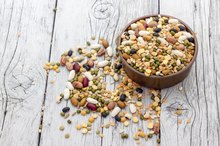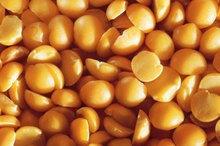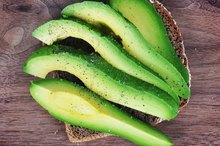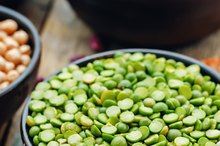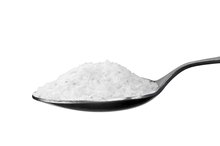What does fact checked mean?
At Healthfully, we strive to deliver objective content that is accurate and up-to-date. Our team periodically reviews articles in order to ensure content quality. The sources cited below consist of evidence from peer-reviewed journals, prominent medical organizations, academic associations, and government data.
The information contained on this site is for informational purposes only, and should not be used as a substitute for the advice of a professional health care provider. Please check with the appropriate physician regarding health questions and concerns. Although we strive to deliver accurate and up-to-date information, no guarantee to that effect is made.
Lentils & Vitamin K
Vitamin K is a nutrient that is important to blood clotting, bone health and cell growth. Any deficiency in vitamin K is not common because the nutrient is readily found in so many different foods. Lentils, a leguminous plant, offer 3.4 mcg vitamin K per cooked cup.
About Lentils
The most commonly found types of lentils are the French, red and yellow varieties. Lentils are usually sold dried, but they can be rehydrated in cans. The legume is often used as a vegetarian source of protein in casseroles, soups and patties. A 1-cup serving of cooked lentils provides 16 g fiber, 18 g protein, 37 percent of the recommended dietary allowance for iron, 36 percent for phosphorus, 18 percent for magnesium and 49 percent for manganese, based on a 2,000-calorie diet. A cup of lentils also has 90 percent of the RDA for folate, which helps promote healthy red blood cell function and supports proper brain development in fetuses.
- The most commonly found types of lentils are the French, red and yellow varieties.
- A cup of lentils also has 90 percent of the RDA for folate, which helps promote healthy red blood cell function and supports proper brain development in fetuses.
Vitamin K Content
Glycemic Index of Lentils
Learn More
Lentils provide 4 percent of the RDA for vitamin K and are not among one of the best sources of this nutrient. The Institute of Medicine recommends most adults consume 90 to 120 mcg of vitamin K daily 1. Vitamin K is a fat-soluble vitamin, meaning it is stored in the liver and other fatty tissue. Your diet must include a minimal amount of fat, 20 percent is recommended by the IOM, to help you best absorb vitamin K.
- Lentils provide 4 percent of the RDA for vitamin K and are not among one of the best sources of this nutrient.
- Your diet must include a minimal amount of fat, 20 percent is recommended by the IOM, to help you best absorb vitamin K.
Boosting K Content
Prepare lentils with vitamin K-rich foods to boost your intake. Saute onions, garlic, celery and carrots in 1 tbsp. of canola oil before adding dry lentils and chicken broth to make a lentil soup. Add spinach or kale to the soup to further boost the vitamin K content. Make a cold lentil salad with a dressing of lemon juice and olive oil and serve over vitamin K-containing green lettuce and watercress. Season cooked lentils with 1/4 cup raw, chopped parsley to obtain an extra 246 mcg vitamin K.
- Prepare lentils with vitamin K-rich foods to boost your intake.
- Season cooked lentils with 1/4 cup raw, chopped parsley to obtain an extra 246 mcg vitamin K.
Considerations
Nutritional Values for Dried Beans Vs. Canned Beans
Learn More
Older adults who are vulnerable to hip fracture and osteoporosis should make an extra effort to consume lentils -- or other meals -- with 1 cup of leafy greens to obtain adequate amounts of vitamin K to protect bone health. Even if you do not add vitamin K-containing foods to lentils, they still provide a wealth of nutrients making them a healthy addition to any diet. Vitamin K supplements are available over-the-counter, but check with your doctor before adding them to your regimen.
Related Articles
References
- Linus Pauling Institute: Vitamin K
- Food.com: Lentil -- Kitchen Dictionary
- Lentils, dry, cooked, fat not added in cooking. USDA FoodData Central. Updated April 1, 2019.
- Abeysekara S, Chilibeck PD, Vatanparast H, Zello GA. A pulse-based diet is effective for reducing total and LDL-cholesterol in older adults. Br J Nutr. 2012;108 Suppl 1:S103-10. doi:10.1017/s0007114512000748
- Ganesan K, Xu B. Polyphenol-Rich Lentils and Their Health Promoting Effects. Int J Mol Sci. 2017;18(11):2390. Published 2017 Nov 10. doi:10.3390/ijms18112390
- Polak R, Phillips EM, Campbell A. Legumes: Health Benefits and Culinary Approaches to Increase Intake. Clin Diabetes. 2015;33(4):198–205. doi:10.2337/diaclin.33.4.198
- Ha V, Sievenpiper J, de Souza R et al. Effect of dietary pulse intake on established therapeutic lipid targets for cardiovascular risk reduction: a systematic review and meta-analysis of randomized controlled trials. Can Med Assoc J. 2014;186(8):E252-E262. doi:10.1503/cmaj.131727
- Sievenpiper JL, Kendall CW, Esfahani A, et al. Effect of non-oil-seed pulses on glycaemic control: a systematic review and meta-analysis of randomised controlled experimental trials in people with and without diabetes. Diabetologia. 2009;52(8):1479-95. doi:10.1007/s00125-009-1395-7
- Rebello CJ, Greenway FL, Finley JW. A review of the nutritional value of legumes and their effects on obesity and its related co-morbidities. Obes Rev. 2014;15(5):392-407. doi:10.1111/obr.12144
- Variety of lentil proteins makes recommendations on avoidance difficult. American Academy of Allergy, Asthma, and Immunology. Published July 24, 2015.
- Legumes (Including Pulses). Anaphylaxis Campaign. Published March 2019.
- Jensen K, Ni Y, Panagiotou G, Kouskoumvekaki I. Developing a molecular roadmap of drug-food interactions. PLoS Comput Biol. 2015;11(2):e1004048. Published 2015 Feb 10. doi:10.1371/journal.pcbi.1004048
- Ndidi US, Ndidi CU, Olagunju A, Muhammad A, Billy FG, Okpe O. Proximate, Antinutrients and Mineral Composition of Raw and Processed (Boiled and Roasted) Sphenostylis stenocarpa Seeds from Southern Kaduna, Northwest Nigeria. ISRN Nutr. 2014;2014:280837. Published 2014 Mar 16. doi:10.1155/2014/280837
- Anti-nutritional Factors. U.S. National Library of Medicine.
- Before You Toss Food, Wait. Check It Out! U.S. Department of Agriculture.
Writer Bio
Andrea Boldt has been in the fitness industry for more than 20 years. A personal trainer, run coach, group fitness instructor and master yoga teacher, she also holds certifications in holistic and fitness nutrition.

